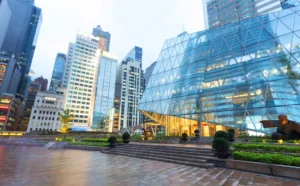This decade is witnessing a steady rise in the demand for commercial assets as a sophisticated class. Once relegated to the purview of the wealthy, entrepreneurial class owing to the substantial investment equity, the market for commercial assets has widened in the contemporary age. Tools such as Real Estate Investment Trusts and fractional ownership have led to relatively lower capital investment and consequentially garnered immense interest from a new, emerging investing class.
Table of Contents
The fact that the Indian economy has never been stronger, the country’s liberal Foreign Direct Investment policies and progressive government initiatives has precipitated a thriving demand for commercial spaces. With a rental appreciation of 8-11% per annum in commercial assets compared to 1.5% to 3% in the residential sector and a steady momentum of increasing demand, the commercial real estate sector is projected to be the most buzzing investment destination in the coming years.
Despite the seemingly advantageous proposition of investing in this booming vertical, it is paramount to understand that the concretization of these apparent benefits is tangential to the selection of the ‘right’ asset. It is important for discerning investors to therefore practice due diligence, conduct thorough research and understand the market dynamics well before investing. Let us discuss some of the key determinants which need to be considered to ensure that you make an investment decision that yields you high returns.
Know the geographical location
One of the most important factors to govern the investment potential of an asset is where it is situated. Different classes of commercial assets require varying geographical details to ensure appreciation. For instance, a locale that is well-connected to ports and harbors will be copacetic for manufacturing units or tenants who deal in import or export. However, office spaces for IT companies require the presence of booming business districts as well as a robust social infrastructure. Further, the presence of different transit systems such as highways, developed roadways, railways, etc in the vicinity is critical to the emergence and success of workspaces.
In addition to this, it is imperative to be cognizant of how the macro success of a particular commercial asset will not necessarily translate to your chosen destinations and vice versa. Every geographical area has its private forces of demand and supply which dictate the success of assets in that area. It is therefore pivotal that in-depth and comprehensive research be conducted to understand the array of factors affecting the profitable viability of an asset in the area.
This can include but is not limited to researching the extant rentable commercial assets and the ongoing or future developments that might emerge in the area. This gives you a clear idea of whether the market is oversaturated or undersupplied with the commercial asset of your choice, enabling you to make an educated decision.
Study the market dynamics
Though the real estate market is a relatively stable investment destination compared to assets such as cryptocurrency and stocks, it is not entirely unscathed by the market forces. The recent years, with the pandemic completely mutating the workforce ecosystem, are evidence of an intimate relation of between the two.
It is therefore necessary for investors to be well-versed in the market cycles of the industry. An investor’s utmost priority should be being abreast of what is trending in the market, with an expansive understanding of what factors need to be analysed and investigated before moving forward with an investment.
A prudent investor should study the prevailing market rents, vacancy rates, profit-loss statements from previous owners of the assets, etc, and conduct a thorough investigation on the feasibility of investing in the market.
Investigate the tenancy profile
Knowing the tenancy behaviour and trends in chosen commercial asset class enables you to create a concrete and concise investment plan. Examining the historical trend related to leasing reveals that while commercial office spaces are usually the easiest to find tenants for, they are usually leased for 5 years. Indisputably, exceptions are there in case it is the headquarters of a company, in which case a longer leasing period might be on the horizon. On the other hand, while special-class commercial assets such as laboratories and niche-specific warehouses might take longer to find tenants, the leasing period of the same is also usually 10 years.
Further, a detailed study of existing tenants, tenants in the vicinity of the property, and their financial prowess can also provide you insight into the future potential of the asset.
Frame an intelligible investment plan
A well-thought plan is the one that has the most potential to be executed fastidiously. Thus a prerequisite of a high-yielding and appreciating commercial space is having a clear investment plan that sets out exhaustively the goal of the investment, and the time period, as well as one that has a contingency plan in case of setbacks.
You need to be clear on whether you’re investing to seek short-term monetary appreciation by buying the asset during the beginning of its life cycle and selling it at a higher price once fully developed, or long-term rental yield. Further, it is necessary to realise that due to market fluctuations that things may not pan out exactly as you planned, and be prepared to deal with it, in form of a cost contingency fund. It is necessary to factor this in as a part of the initial acquisition cost so that you might have a better picture of the future of the asset.
Develop a dependable framework of counsel
It does not matter whether you’re a veteran investor, it is always sounder to seek expert counsel when it comes to navigating the complex terrains of investing in a commercial asset. From understanding the tax laws to different financing options available to conducting a review of all legal documents pertaining to ownership, soliciting counsel from legal experts will help in avoiding future hassle. This can be related to hidden costs, unpaid insurance premiums, ambiguous ownership clauses, etc.
Final Thoughts:
Investing in commercial properties in India can be a profitable venture yielding a stable long-term cash flow and capital appreciation. However, it is also important to consider the above-mentioned factors carefully to ensure that you select the right investment destination, tailored to your specific goals.








